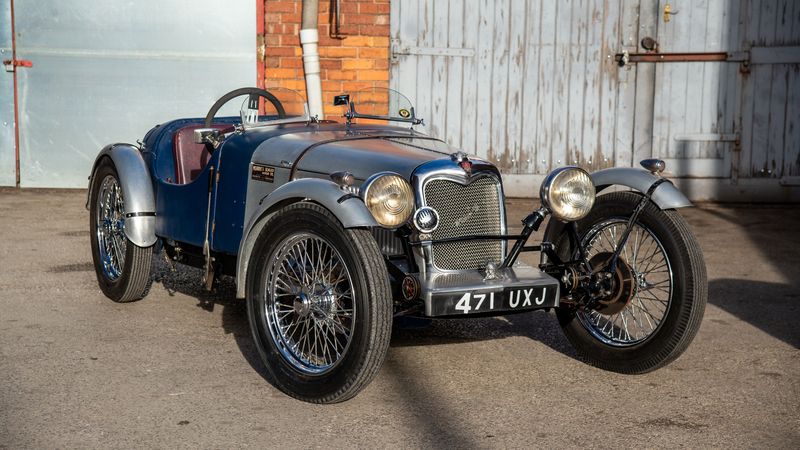RESERVE LOWERED - 1938 Rover 10 Special
Highlights
• Inexpensive alternative to a Thirties original
• Modified, tuned engine spec
The Background
It was the first models built after the firm was taken over by Wilks brothers, with the model being aimed squarely at the quality end of the market. It featured a pressed steel four-door saloon body, while the chassis itself was also made available to coachbuilders.
The History
At that time it was still wearing its standard steel four-door body. However, both body and mechanicals were in decidedly poor condition, so, with some fairly extensive chopping and trimming, the car was converted into a racing-style ‘special’ after the manner of a Brooklands Riley.
The car was built using MCC classifications and guidelines for hill climbing. It has never been raced and would require the wire wheels to be changed to competition specification. The car is fully road legal
The Paperwork
The rebuild covers a period from around 2004 to 2016, with further improvements undertaken from the present owner.
The Exterior
The engine cover, valance and cycle wings are made from aluminium. They are nicely fashioned and fit well, with the both sides of the engine cover opening and closing smoothly.
The Interior
The floor is rudimentary wooden boarding and the transmission tunnel is aluminium.
The custom-made seats are in decent condition. That on the passenger side is adjustable for rake, though the driver’s is fixed. Pilots of six foot or under should be fine.
The Mechanics
The engine is an Austin Rover A+, of around 1972 vintage, bored out from 1.3-litres to 1.4 litres. It boasts light alloy racing pistons, a balanced crank and fast road cam, titan rockers, as well as a lightened flywheel and a tooth belt timing chain conversion. It’s highly likely that the cylinder head is from a Sixties Mini Cooper.
The four-cylinder is fed via a Weber 40 DCOE Carburettor and runs through a Ford four-speed gearbox. With quick, modern-style starting in mind, the Rover has recently been fitted with a ‘Powerlite’ reduction starter and new alternator, both of which are designed to work well with the new, lightweight lithium battery. The motor and its ancillaries all look to be in very good shape, with healthy-looking hoses, leads and wiring, and no signs of leaks.
Again, everything looks to be in very good shape, with no signs of significant wear, and only the odd brush of surface corrosion along some edges. Suspension and steering look to be very sound.
The Appeal
And don’t forget, someone has really gone out of their way to give this roadster quite a pokey engine (and the car weighs not more than a shoe box) – so you can expect more than your fair share of wind through the hair. Remember to add the price of a pair of goggles to your bid.
Notice to bidders
- Year 1938
- Make Rover
- Model 10 Special
- Colour Silver & Blue
- Odometer 82,172 Miles
- Engine size 1398
- Seller Type Private
- Location Yorkshire
- Country United Kingdom
- Lj•••• £13,500 06/12/21
- jo•••• £13,250 06/12/21
- Lj•••• £13,000 06/12/21
- Lj•••• £12,750 06/12/21
- Lj•••• £12,500 06/12/21
- jo•••• £12,500 06/12/21
- Lj•••• £12,250 06/12/21
- Lj•••• £12,000 06/12/21
- TV•••• £11,750 06/12/21
- Lj•••• £11,500 06/12/21
The Gallery

About Max Bids
The max bid process allows you to bid without any hassle.
Enter your maximum bid and we will then bid on your behalf to ensure you're the highest bidder - just enough to keep you in the lead and only up until your maximum.
Anti-sniping
Car & Classic prevent auction snipers from bidding in the last seconds to win an auction.
Auctions are extended by 3 minutes if anyone bids within the last 2 minutes to allow other bidders to react and counter-bid.
Auto-bidding increments
- If your maximum bid is equal to or below the reserve price, your maximum bid will be applied in full if you are the highest bidder.
- If you are the highest bidder and place a maximum bid above the reserve, we will automatically put in the reserve as your first bid.
-
- Once the reserve has been met, Car & Classic will make sure you are the highest bidder using only the bidding increments stated below.
- We will keep you in the lead up until your maximum bid OR the increment closest to your maximum bid, providing your maximum bid is enough to cover the increment value.
| Bid Amount | Increment |
|---|---|
| £0 to £9,999 | £100.00 |
| £10,000 to £49,999 | £250.00 |
| £50,000 to £99,999 | £500.00 |
| £100,000 + | £1,000.00 |
Automatically outbid immediately
When you place a max bid and are outbid immediately that means that another bidder has placed a max bid limit which is higher than yours.
You can bid again and we will use our automatic bid system to try and get you as the highest bidder.
Matching max bids
When there are two max bids of the same value, the one placed first remains the lead bidder.
Pre-authorisation
We may hold a pre-authorisation charge on your card until the end of the auction when the hold will be cancelled. If you win, we'll take a security deposit which counts towards the payment for the vehicle and isn't any extra cost to you.
What are pre-bids?
A pre-bid means you're able to place a bid before the official start of the auction.
You will be notified whether or not you are the highest bidder when the auction starts.
Problem with your bid
Bids are contractually binding. To help protect you, we have some rules in place if we think it's been mistyped. Please check and amend what you have entered.




























































































































































































